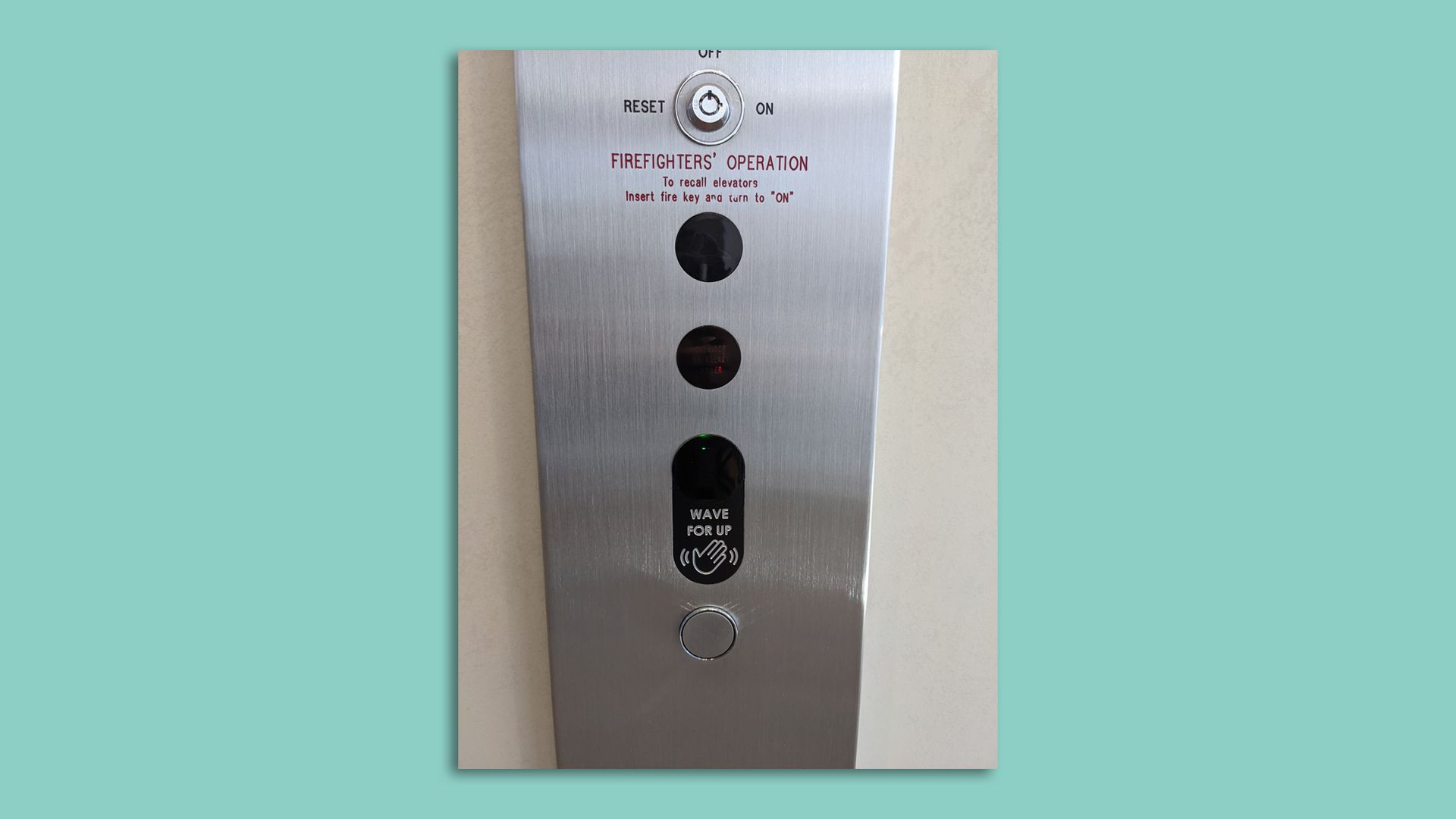| | | | | | | Presented By West Monroe | | | | Axios What's Next | | By Jennifer A. Kingson, Joann Muller and Erica Pandey ·Oct 25, 2021 | | 3D-printed homes are being eyed as a solution to the housing affordability crisis — if they can be built in a climate-friendly way and prove structurally sound in the long term. - Today's reader photo comes from Radha Saikia, who spotted the likely future of elevator buttons.
- Have you seen something cool lately? Send us a photo at whatsnext@axios.com.
Today's Smart Brevity count: 1,083 words ... 4 minutes. | | | | | | 1 big thing: 3D-printed houses seem poised to go mainstream |  | | | A rendering of a planned 3D-printed, net-zero-energy community in Rancho Mirage. Photo: Mighty Buildings | | | | 3D-printed cement houses are about to take off, offering a cheaper, more efficient way to provide homes for those who need them — as long as they can be built in ways that don't worsen climate change, Joann Muller writes. Why it matters: Developers of 3D-printed homes think they can take on multiple challenges: the affordable housing crisis, the shortage of skilled labor and rising material costs. - At least one is also adapting its technology to mass-produce homes without releasing too much carbon into the atmosphere.
What's happening: A handful of companies are erecting new subdivisions featuring 3D-printed houses. - Instead of conventional materials like steel, aluminum and lumber, 3D-printed structures are built by a robot squeezing a cement mixture out of a nozzle, layer upon layer, like a soft swirl ice cream cone.
- It's the same additive manufacturing process used to make everything from dental implants to airplane parts — just on a much, much larger scale.
- Only a few dozen 3D-printed homes have been built, or proposed, so far in the U.S., but that's about to change.
What they're saying: "After years of R&D, the market is nearing a tipping point as companies are moving beyond pilots and demonstration projects," according to market researchers at Guidehouse Industries. Where it stands: Among the early pioneers is Austin, Texas-based ICON, which has delivered more than two dozen 3D-printed homes in the U.S. and Mexico and just raised $207 million to expand. - The company prints homes on-site, using its Vulcan construction system, with a gantry-mounted nozzle that lays down the house's walls, layer by layer.
Mighty Buildings, a competitor, offers an alternative that focuses equally on the housing and climate crises. - The San Francisco-based company aims to become carbon neutral by 2028 — more than two decades ahead of the rest of the construction industry.
Yes, but: Construction is a major contributor to climate change. It takes enormous amounts of energy to produce cement, a key ingredient in concrete, the ubiquitous foundation of our built world. The bottom line: It's too early to say whether 3D-printed houses will meet the test of time, says Henry D'Esposito, construction research lead at JLL, a real estate services firm. - "We've never seen one of these at 20, 30, 40 years old," he tells Axios.
Read the full story. |     | | | | | | 2. Vinyl craze leads to supply squeeze |  | | | Illustration: Aïda Amer/Axios | | | | Vinyl records are hot again — outselling CDs in 2020. But there aren't enough manufacturers to fill the demand, Erica Pandey writes. The big picture: Orders are delayed weeks or months, and artists are having to set release dates several months in advance to allow time for the newly popular vinyls to be made. The squeeze is due in part to the pandemic, per the New York Times. - Many manufacturing plants shuttered, and there was a shortage of polyvinyl chloride, the material used to make vinyl records.
- The machines used to make records are also outdated and often decades old — leftover from when vinyls were last this popular, the Times reports. New machines are in short supply and cost hundreds of thousands of dollars.
Case in point: Adele announced the release date for her November album six months in advance to allow time for vinyl record production. What to watch: 2021 vinyl sales have already eclipsed 2020 sales, as music-lovers — especially younger ones — fall back in love with the old way of listening to albums. Look for the supply squeeze to continue as the craze keeps intensifying. Share this story. |     | | | | | | 3. Charted: What techies make around the country |  Data: Hired.com; Chart: Will Chase/Axios Tech jobs are scattered across the country, but salaries vary widely by city, per a new report from Hired, Erica writes. Why it matters: The pandemic normalized teleworking, and now workers — especially those in remote-capable tech jobs — are increasingly likely to live in one city but work for a company based in another. But that might affect compensation. - Philly is in the bottom tier, but salaries there are "comparable to general tech job salaries in other emerging tech hubs like Austin, San Diego and Washington, D.C.," Axios Philadelphia's Taylor Allen writes.
- Chicago's average (not charted) is even lower than Philly, at $133,000. "Despite a decade of municipal efforts to build up Chicago as a Midwest Silicon Valley, local tech salaries lag behind many of the top cities in the nation," writes Axios Chicago's Monica Eng.
What to watch: 52% of tech workers surveyed by Hired said they preferred a remote-first working model. And 74% of tech workers said they'd start looking for new jobs if their salaries didn't increase or if they were denied raises in six months. - A number of tech companies, including Reddit and Basecamp, have said they will no longer tie compensation to place, paying employees Bay Area salaries no matter where they live. Look for more tech firms to follow suit in order to stay competitive in the war for talent.
Share this story. |     | | | | | | A message from West Monroe | | Agile, digital businesses can handle a scarcity of resources | | |  | | | | Scarcity shouldn't be a hindrance to innovation—it should be an enabler. With a digital mindset, businesses can reframe scarcity-related challenges to take risks, make bold choices, and drive progress. Learn how to manage scarcity with agility. | | | | | | 4. Existing home sales hit inflection point |  Data: National Association of Realtors; Chart: Jacque Schrag/Axios Homebuyers were busy this summer: They closed on 6.29 million properties in September on a seasonally adjusted annualized rate, up 7% from August, according to the National Association of Realtors, Hope King writes in Axios Markets. Why it matters: Lower mortgage rates made purchasing an attractive option, despite higher sales prices. - Demand has pushed up the median sales price by 13.3% compared to a year ago.
Yes, but: Lack of affordability kicked first-time homebuyers out — they made up 28% of sales, the lowest level in six years. By the numbers: Though prices are up substantially from a year ago, September's median price of $352,800 showed a slight cooling compared to August. - Inventory dropped 13% from last year.
- The average 30-year fixed rates fell below 3% in August.
What we're watching: Over the next six months, sales may trend down as mortgage rates rise, and with inventory near record lows and home buying sentiment at 39-year lows, Matthew Pointon, senior property economist at Capital Economics, wrote in a research note. Read the full story. |     | | | | | | 5. Reader photo of the day |  | | | Photo: Radha Saikia | | | | What's Next: Haptic gestures replace elevator buttons Radha Saikia writes: "This was the coolest elevator button — you just waved to call an elevator. It worked so well I was surprised. "This picture is from Edmonton, Canada. I saw it in my dentist's building. "More and more things are going touchless since the pandemic, and it seems like the trend is continuing!" |     | | | | | | A message from West Monroe | | Leading companies treat digital as a mindset, not a project | | |  | | | | Bottom line? Digital transformation projects fail. Your business either has a digital mindset, or it doesn't, so: - Treat digital as a team sport.
- Solve business challenges, not technical needs.
- Organize around the customer and never stop adapting.
Learn how to become a digital business. | | | | Was this email forwarded to you? Get the daily dose of What's Next magic by signing up for our free newsletter here. |  | | It'll help you deliver employee communications more effectively. | | | | | | Axios thanks our partners for supporting our newsletters. If you're interested in advertising, learn more here.
Sponsorship has no influence on editorial content. Axios, 3100 Clarendon Blvd, Suite 1300, Arlington VA 22201 | | | You received this email because you signed up for newsletters from Axios.
Change your preferences or unsubscribe here. | | | Was this email forwarded to you?
Sign up now to get Axios in your inbox. | | | | Follow Axios on social media:    | | | | | |










No comments:
Post a Comment